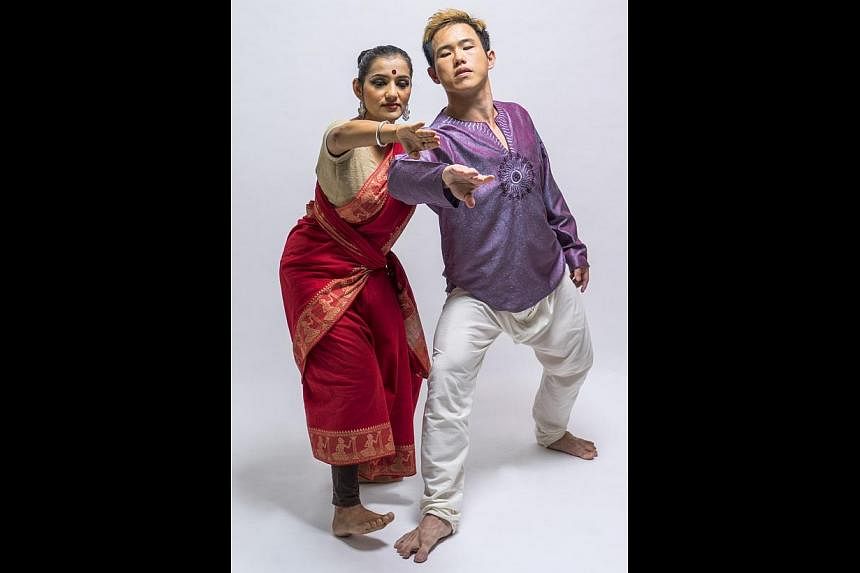In Gitanjali, arguably Rabindranath Tagore's most famous collection of poems, the Indian poet writes: "Do you not feel a thrill passing through the air with the notes of the far away song floating from the other shore?"
The late Nobel laureate, who wrote these verses in Bengali before they were translated into English, was a key source of inspiration for playwright Haresh Sharma and director Alvin Tan for The Necessary Stage's upcoming production, also titled Gitanjali (I Feel The Earth Move).
The call of distant shores and the push and pull of past and future abound in this multi-disciplinary production, which the duo say is one of their "most ambitious" yet.
Sharma, 49, says: "There are all these elements of leaving home and starting anew, being tied to your homeland or to tradition, whether in dance, family or culture."
The play stars Padma Sagaram as the elderly owner of a classical dance school in India who is looking for a successor.
Her son (Ebi Shankara) insists on leaving the country and her protege (Raka Maitra) moves to Canada to start her own dance school fusing Eastern and Western traditions.
Desperate, she puts out a call for an arranged marriage that might help her son remain in India, and gets a response from a young Singaporean Indian woman (Sharda Harrison).
This complex web of relationships is perhaps also a metaphor for the plethora of genres that Gitanjali takes on, fusing dance, drama, music, literary elements and multimedia in a kaleidoscopic show that will run at the School of the Arts Drama Theatre from Sept 26 to 28.
The group has roped in professional odissi dancer and choreographer Maitra, French-Laotian contemporary dancer-choreographer Ole Khamchanla and Singaporean contemporary dancer Jereh Leong to bring together the movement portions of the production.
This clash of art forms has proven to be creatively fruitful.
Tan, 51, also artistic director of The Necessary Stage, says: "We got Ole, Raka, Sharda and Jereh and musician Bani Haykal into a rehearsal room and tried three to four hours of workshopping to see if there was any chemistry, synergy, resistance or potential collaborators. They all liked one another and could work with one another."
Gitanjali marks Maitra's first time performing in a play, which she found very challenging.
In dance, director Tan says there is a great deal of "copying" to attain a certain precision in choreography, whereas in theatre, copying is "the worst thing you can do".
"The director normally tells you something, asks what it inspires in you and you have to have ownership of it," he says.
Maitra, 43, laughs: "I'd always thought a director tells you exactly what to do. When they asked me to be a part of this, they didn't tell me I had lines. I thought I was here to dance. But, surprise, there's a script with lines."
Tan and Sharma already had Maitra in mind for the part, knowing that she was pushing the boundaries with traditional dance forms in her own practice.
She says: "As a dancer, I can relate to it. There's a dance teacher leaving a tradition and going to do contemporary dance. I feel I can understand the character.
"I've been experimenting with classical dance for the last 10 years, so I did find a lot of resistance and criticism. Even now because people don't know how to define you. People like to box you up as a classical dancer or a contemporary dancer. I'm somewhere in between."
These tensions between modernity and tradition have been worked into the production, which interrogates these issues, set against the lyricism of Tagore's poetry.
The production's origins, however, are much more straightforward than the complex creature it has created. Tan chuckles: "The truth is, last year Haresh said, 'I want to do a play about my people,' and that was it."
Sharma adds, tongue in cheek: "I felt I wanted to work with Indian artists. We've worked with very few of them. Our recent plays have focused on the Malay and Chinese.
"It had to be a conscious effort, we had to sound it out to the universe that we wanted to work with Indian artists."
But as they dug deeper into Indian culture and the work of Tagore, they uncovered much more.
He was deeply intercultural, a "nexus between East and West" as Tan puts it. He feels that Tagore had a poetic vision that went beyond his time.
Tan says: "For me, that inspires the contemporary story of the dance teacher - do I keep tradition per se or is the best way to pay tribute to tradition to have tradition converse with modernity? That is, for me, the spirit of Tagore."
Follow Corrie Tan on Twitter @CorrieTan


